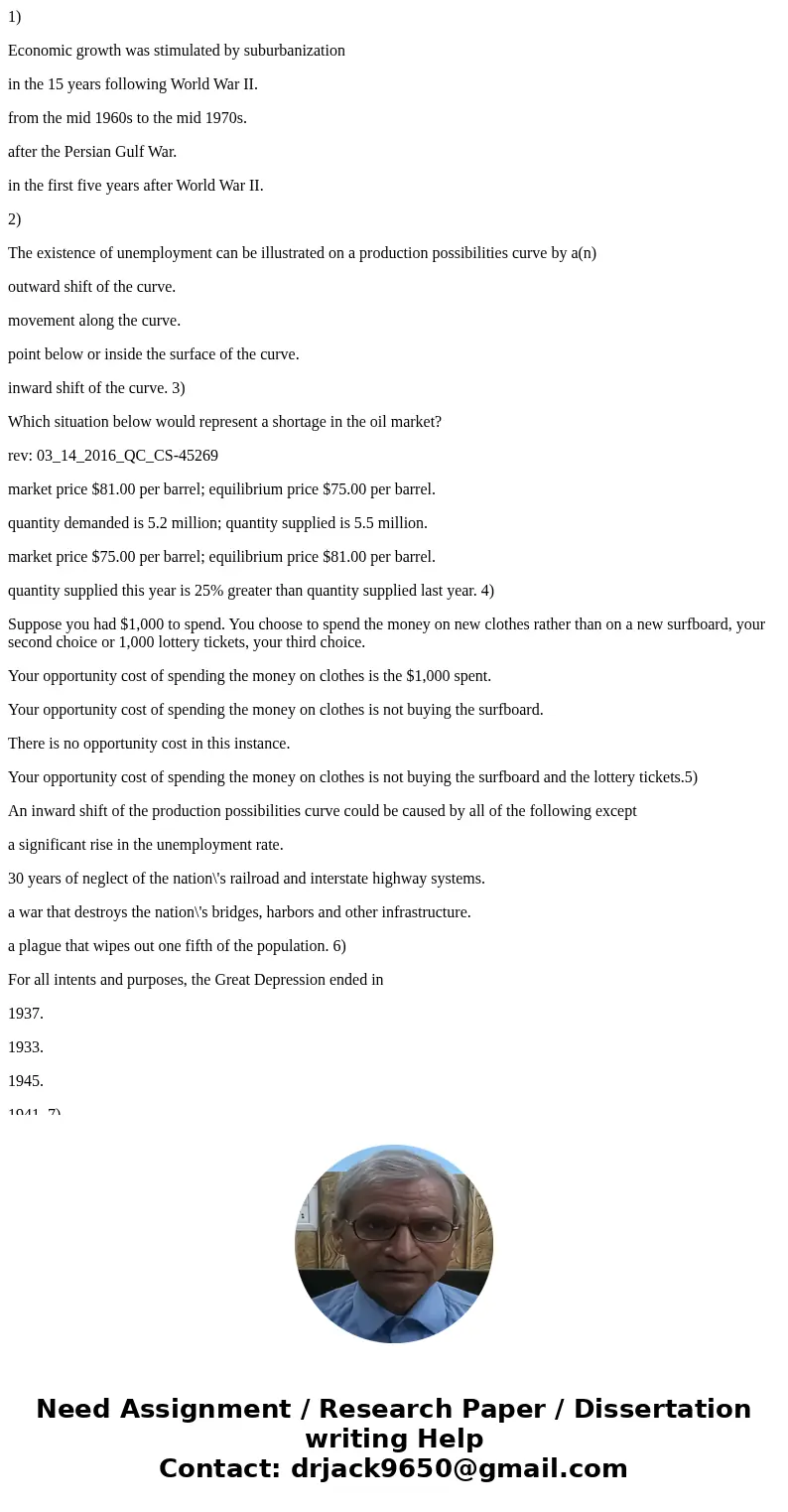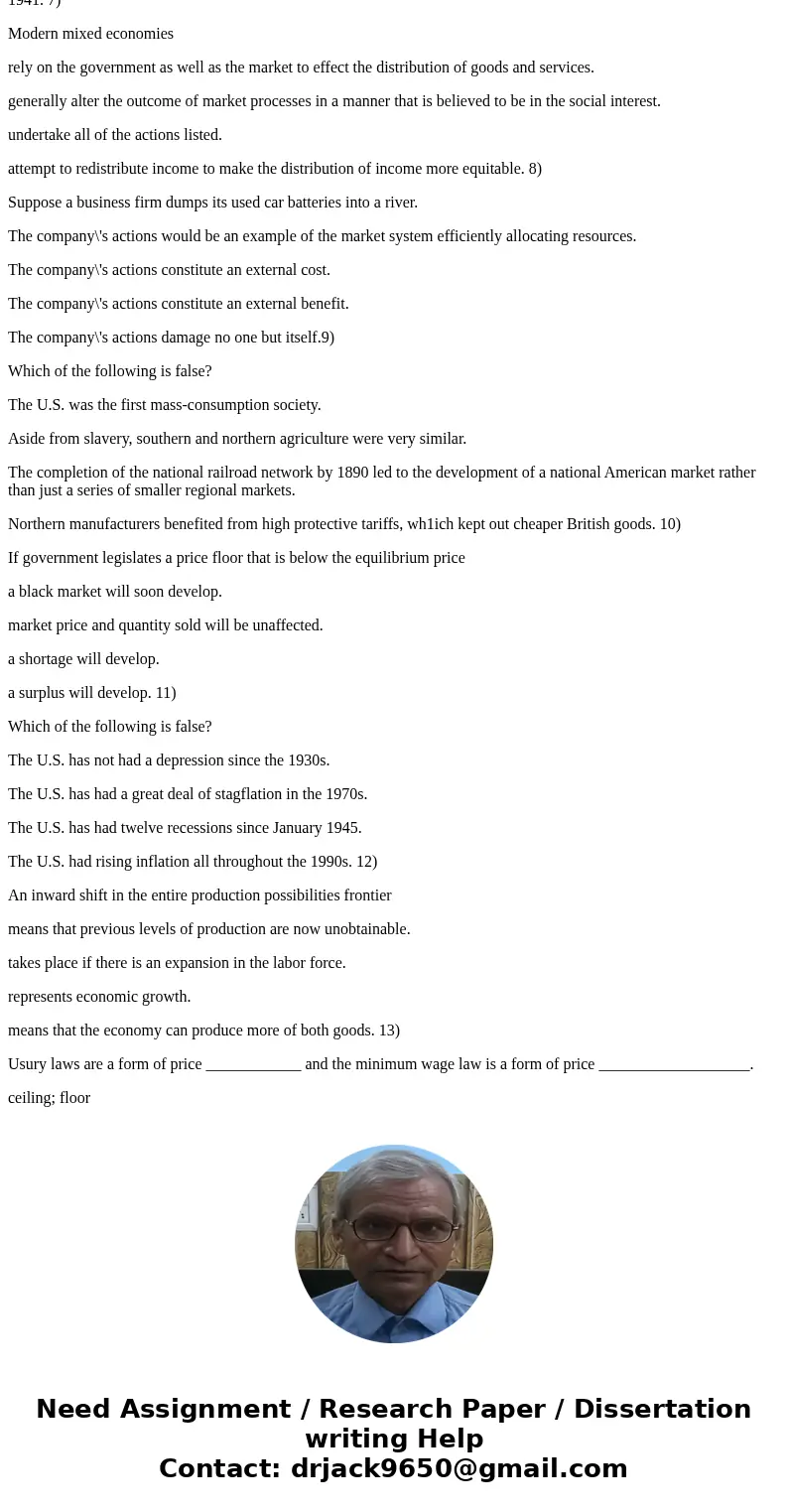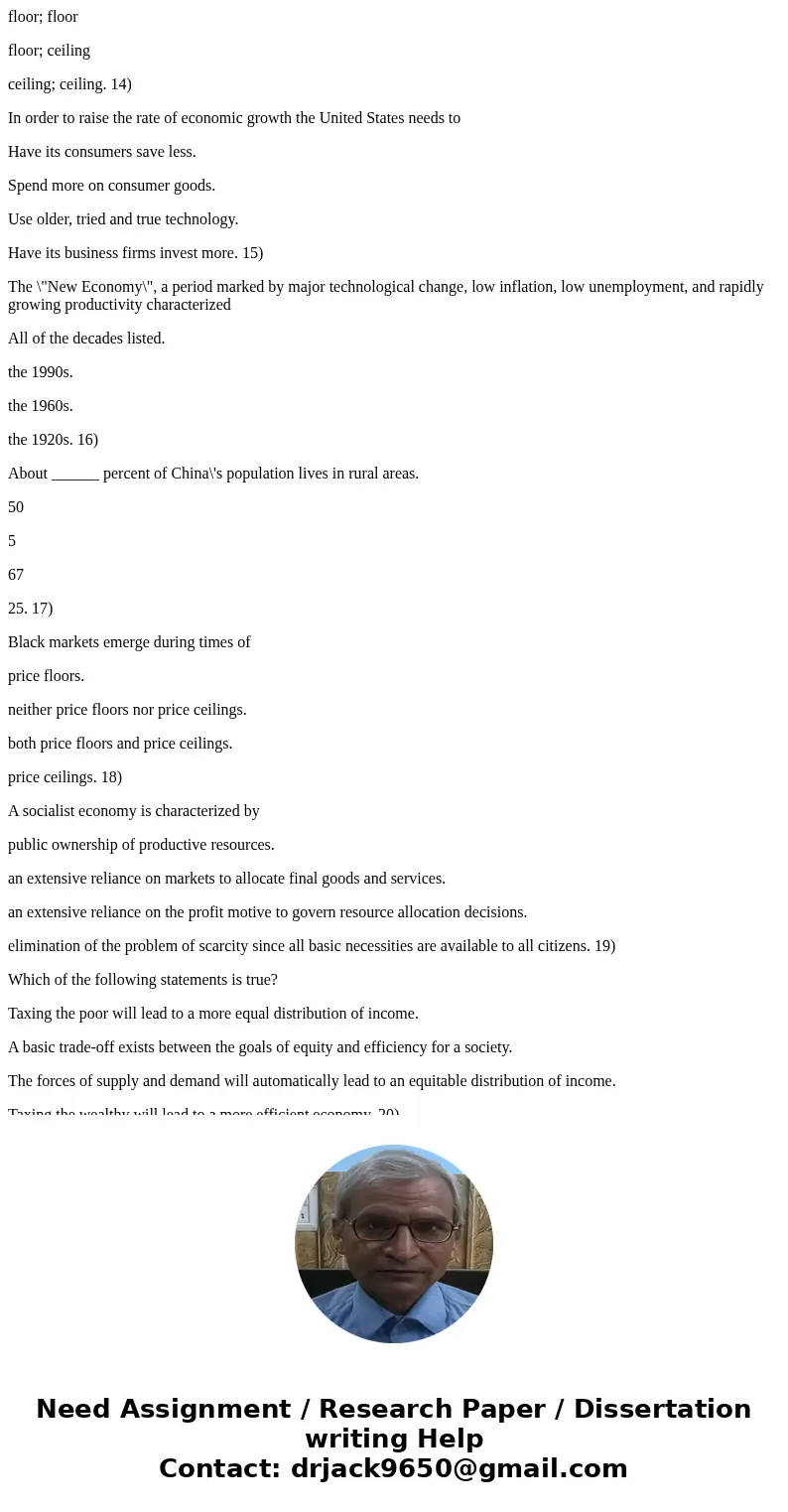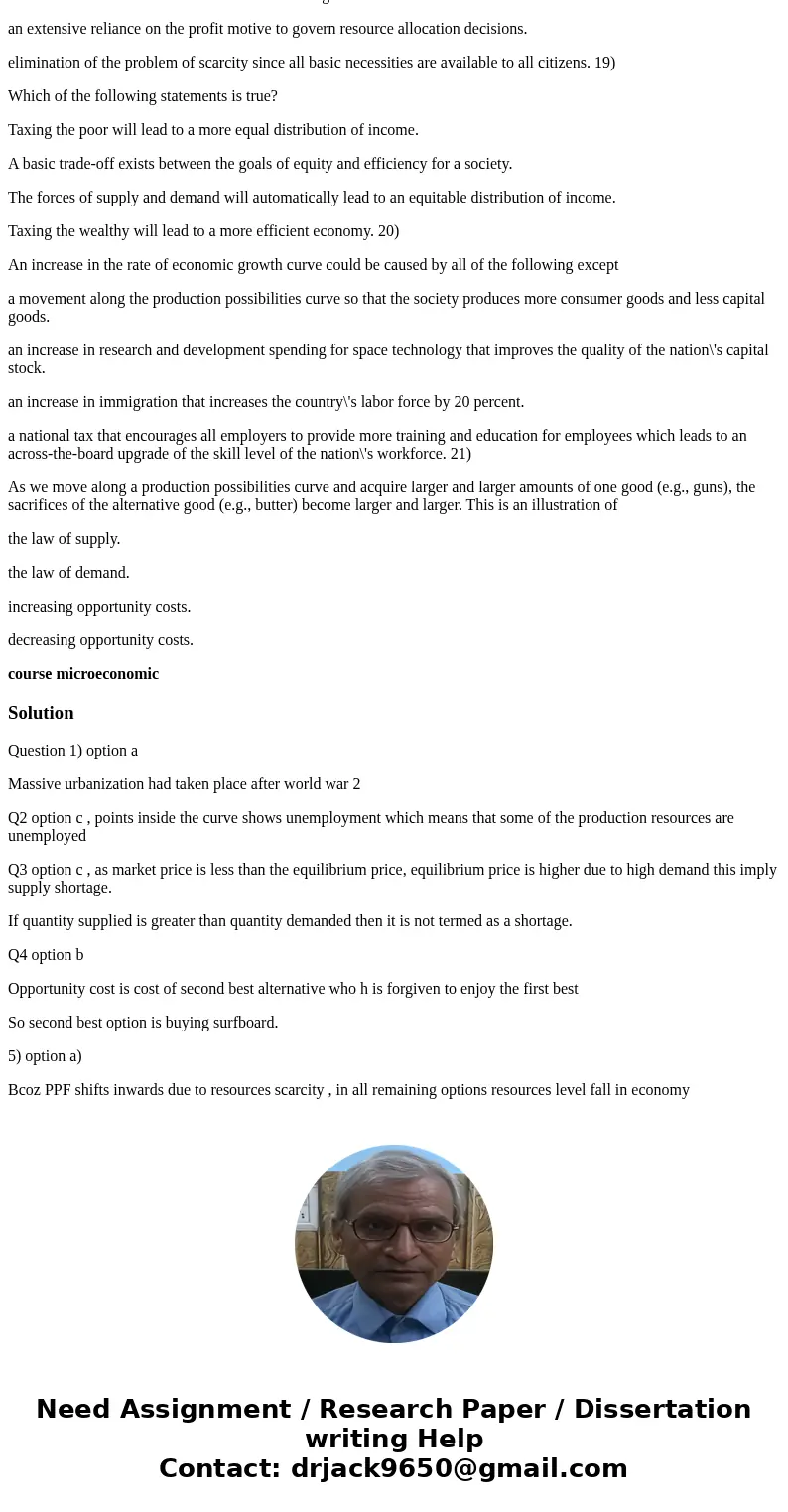1 Economic growth was stimulated by suburbanization in the 1
1)
Economic growth was stimulated by suburbanization
in the 15 years following World War II.
from the mid 1960s to the mid 1970s.
after the Persian Gulf War.
in the first five years after World War II.
2)
The existence of unemployment can be illustrated on a production possibilities curve by a(n)
outward shift of the curve.
movement along the curve.
point below or inside the surface of the curve.
inward shift of the curve. 3)
Which situation below would represent a shortage in the oil market?
rev: 03_14_2016_QC_CS-45269
market price $81.00 per barrel; equilibrium price $75.00 per barrel.
quantity demanded is 5.2 million; quantity supplied is 5.5 million.
market price $75.00 per barrel; equilibrium price $81.00 per barrel.
quantity supplied this year is 25% greater than quantity supplied last year. 4)
Suppose you had $1,000 to spend. You choose to spend the money on new clothes rather than on a new surfboard, your second choice or 1,000 lottery tickets, your third choice.
Your opportunity cost of spending the money on clothes is the $1,000 spent.
Your opportunity cost of spending the money on clothes is not buying the surfboard.
There is no opportunity cost in this instance.
Your opportunity cost of spending the money on clothes is not buying the surfboard and the lottery tickets.5)
An inward shift of the production possibilities curve could be caused by all of the following except
a significant rise in the unemployment rate.
30 years of neglect of the nation\'s railroad and interstate highway systems.
a war that destroys the nation\'s bridges, harbors and other infrastructure.
a plague that wipes out one fifth of the population. 6)
For all intents and purposes, the Great Depression ended in
1937.
1933.
1945.
1941. 7)
Modern mixed economies
rely on the government as well as the market to effect the distribution of goods and services.
generally alter the outcome of market processes in a manner that is believed to be in the social interest.
undertake all of the actions listed.
attempt to redistribute income to make the distribution of income more equitable. 8)
Suppose a business firm dumps its used car batteries into a river.
The company\'s actions would be an example of the market system efficiently allocating resources.
The company\'s actions constitute an external cost.
The company\'s actions constitute an external benefit.
The company\'s actions damage no one but itself.9)
Which of the following is false?
The U.S. was the first mass-consumption society.
Aside from slavery, southern and northern agriculture were very similar.
The completion of the national railroad network by 1890 led to the development of a national American market rather than just a series of smaller regional markets.
Northern manufacturers benefited from high protective tariffs, wh1ich kept out cheaper British goods. 10)
If government legislates a price floor that is below the equilibrium price
a black market will soon develop.
market price and quantity sold will be unaffected.
a shortage will develop.
a surplus will develop. 11)
Which of the following is false?
The U.S. has not had a depression since the 1930s.
The U.S. has had a great deal of stagflation in the 1970s.
The U.S. has had twelve recessions since January 1945.
The U.S. had rising inflation all throughout the 1990s. 12)
An inward shift in the entire production possibilities frontier
means that previous levels of production are now unobtainable.
takes place if there is an expansion in the labor force.
represents economic growth.
means that the economy can produce more of both goods. 13)
Usury laws are a form of price ____________ and the minimum wage law is a form of price ___________________.
ceiling; floor
floor; floor
floor; ceiling
ceiling; ceiling. 14)
In order to raise the rate of economic growth the United States needs to
Have its consumers save less.
Spend more on consumer goods.
Use older, tried and true technology.
Have its business firms invest more. 15)
The \"New Economy\", a period marked by major technological change, low inflation, low unemployment, and rapidly growing productivity characterized
All of the decades listed.
the 1990s.
the 1960s.
the 1920s. 16)
About ______ percent of China\'s population lives in rural areas.
50
5
67
25. 17)
Black markets emerge during times of
price floors.
neither price floors nor price ceilings.
both price floors and price ceilings.
price ceilings. 18)
A socialist economy is characterized by
public ownership of productive resources.
an extensive reliance on markets to allocate final goods and services.
an extensive reliance on the profit motive to govern resource allocation decisions.
elimination of the problem of scarcity since all basic necessities are available to all citizens. 19)
Which of the following statements is true?
Taxing the poor will lead to a more equal distribution of income.
A basic trade-off exists between the goals of equity and efficiency for a society.
The forces of supply and demand will automatically lead to an equitable distribution of income.
Taxing the wealthy will lead to a more efficient economy. 20)
An increase in the rate of economic growth curve could be caused by all of the following except
a movement along the production possibilities curve so that the society produces more consumer goods and less capital goods.
an increase in research and development spending for space technology that improves the quality of the nation\'s capital stock.
an increase in immigration that increases the country\'s labor force by 20 percent.
a national tax that encourages all employers to provide more training and education for employees which leads to an across-the-board upgrade of the skill level of the nation\'s workforce. 21)
As we move along a production possibilities curve and acquire larger and larger amounts of one good (e.g., guns), the sacrifices of the alternative good (e.g., butter) become larger and larger. This is an illustration of
the law of supply.
the law of demand.
increasing opportunity costs.
decreasing opportunity costs.
course microeconomic
Solution
Question 1) option a
Massive urbanization had taken place after world war 2
Q2 option c , points inside the curve shows unemployment which means that some of the production resources are unemployed
Q3 option c , as market price is less than the equilibrium price, equilibrium price is higher due to high demand this imply supply shortage.
If quantity supplied is greater than quantity demanded then it is not termed as a shortage.
Q4 option b
Opportunity cost is cost of second best alternative who h is forgiven to enjoy the first best
So second best option is buying surfboard.
5) option a)
Bcoz PPF shifts inwards due to resources scarcity , in all remaining options resources level fall in economy




 Homework Sourse
Homework Sourse